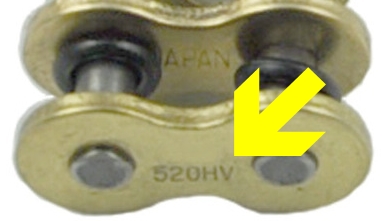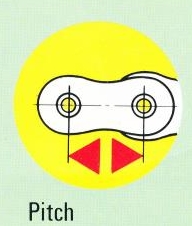No products
Product successfully added to your shopping cart
There are 0 items in your cart. There is 1 item in your cart.
Faqs By Drive Chains
Choosing the correct chain
MOTORCYCLE CHAINS:
Chain sizes:
The size of the chain can usually be found on the side of a link.

Generally sizes are referred to as 'pitch X length'.
Example: 428X114 - pitch of 428 and chain length of 114 links.
The distance between the chain pins is referred to as the ‘Pitch’.

Chain Types:
Standard Chain: is a regular chain suited for smaller road bikes. (125cc-250cc)
Heavy Duty Chains: popular for mid- sized road bikes & most MX bikes.
O-ring Chain: Suitable for most road bikes over 400cc & also for MX/Enduro use. They retain lube better than HD chains.
Z-ring or X-ring Chains: Both retain grease longer than an O-ring due to the shape of the rubber rings.
- Joining Links:
- There are three basic types of chain joining links. Clip links, semi rivet links and full rivet links.
- Clip links use a side plate which is a sliding fit, is assembled with your fingers and is held in place with a U shaped clip on the outside of the link. The closed end of the U shaped clip needs to be fitted facing the chain driving direction. Depending on the make and type of chain they are safe to around 45 bhp. These days they are mainly used on relatively low power and smaller bikes.
Semi rivet links use a side plate that has to be pressed on with a tool but is then retained with a U shaped clip link. These are used in more moderate power bikes where a full rivet link is not needed and a full riveting tool is not required.
Full rivet links use a side plate that is pressed on with a tool and then you either rivet over or open out the chain pins depending on the design. Fitted correctly they are just a strong as all the other links and are permanent. They can be removed but cannot be refitted.
Chain Maintenance:
Road bikes: Lubricate chain every 500-800 km’s.
Off-road/motocross bikes: Depending on riding conditions, however lubrication recommended after each ride and after each high pressure clean. Allow chain lube sufficient time to dry before riding again.
Chain Replacement:
The motorcycle chain's appearance will be a good indicator of when to change your bike chain. If it's stretched or twisted, it's time to change your bike chain. You should also take a close look at the chain links, making sure that they're not worn. If they are, change them.
Always replace the chain and both sprockets at the same time. A worn component will shorten the life of the rest.




